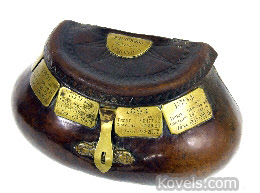Before I made my own version of a classic "pot bellied" creel, I wanted to study some of the material options available at the time. Creels made of leather seem to be some of the earliest and rare forms to have survived. Experts date some back to the 18th century but as you can see below, they were still being used in the late 1800's as well. Most of these are English in origin but who's to say they didn't make it to the States.
 | ||
| Leather Creel Listed as 18th Century |
I found one fine example adorned with the former owner's fishing triumphs, celebrated with brass plaques dating to the 1890's. Maybe the 90's angler was using a family heirloom.
 |
| Image Courtesy Kovels.com |
As much as I love to work in leather, the challenge of a large molded form was a little intimidating to say the least. I also had a problem with the idea of putting slimy little fishies into a leather container, so I decided to pass on leather.
I imagined the possibility of a wooden creel but wasn't sure how that might have worked. The weight issue of a wooden form caused me to think that a lightweight, bentwood design might have developed. Bentwood storage boxes were very popular in the 19th century but I couldn't find an early example of a bentwood creel and I wasn't interested in creating a fantasy piece.
 |
| Image Courtesy mullocksauctions.co.uk |
Long after my creel project was completed, a bentwood creel did turn up and proved my hunch. As you can see in the pictures it does possess round storage box characteristics. Perhaps a fun project in the future.
 |
| Image Courtesy mullocksauctions.co.uk |
Continuing on, I toyed with the idea of metal for creel material. Tinsmiths could make almost anything imagined so it seem plausible. My research didn't turn up a datable example, so I continued on with my quest. Never say never as I recently discovered what may be a rare tinplate (or zinc?) creel from the mid to late 19th century. I'm no expert but its potbellied form is undeniably classic and combined with the construction details, screams "early". Hmmm, maybe another future project ?
 | ||||
| Sheet Metal Creel, Unknown Age |
I finally decided to reproduce a basket creel. Many early 19th century angler's guide books describe creels as baskets and the earliest photographic and print evidence supports their popularity as well. I know that center hole basket creels have been around at least since the 17th century. Robert Venable's book "The Experienc'd Angler", published in 1662, shows one in its front piece illustration seen below.
 | |||
| Image Source Unknown |
Centuries later the popularity of baskets as creels continued as seen in the print below.
 | |
| 1831 "Implements for Fishing" Print, Note the Creel at Top |
Some of the most appealing 19th century basket creels were made of finely split willow and according to some accounts, many of the earliest were French in origin. Later imitations of French creels were apparently produced in Japan. Imitation or not, they are beautifully made and way beyond my skill level to reproduce.
 | |||
| A Classic Early Split Willow Creel |
 |
| Mid-19th Century English Angler's Club |
When I finally turned up a little less refined 19th century willow creel, I felt there was hope for my reproduction project to continue. Apparently, not all creels were works of art.
 | |
| Early English Willow Creel |
All I was left to do was locate a source for the proper willows and a pattern for a creel. Just that. I lucked out when I discovered Bonnie Gale's English Basketry Willows. Not only did Bonnie sell the exact willows I needed for the project, she also offered a beautiful basic creel pattern seen below.
I figured the pattern would give me the basic form and I could amend as I built the creel to get closer to the pot-bellied shape. That was the "plan" at least. After the willows arrived in a very l-o-n-g bundle, I did a little experimenting to discover what I had gotten myself into. The willows have to be soaked to be pliable but not too long mind you. Too long and they get all mooshy. They needed to be just right. After their soaking and while they are waiting to be woven, you wrap them in a damp towel to keep them pliable. Good thing we have two bathrooms, as the only place that I could soak the willows, was in my bathtub.
First I needed to grade the willows by size and make some choices on weave designs. Bonnie's pattern was awesome but in truth, I had no idea what I was doing. That's never stopped me before and so armed with excellent instructions, I plunged ahead. One thing I learned right off was that you need to have strong fingers, about five more than nature provides. You also need room to swing the willows around as you weave.
I'm pretty happy with the way my beginner basket / creel turned out but I can almost hear Bonnie saying, "your third one will be even better".
Front view of my finished English Willow "Pot - Bellied" Creel.
Back view showing the hanging ring seen on early examples. Note also the curved
shape to hug your hip and the holes for the strap
Side view showing the narrow profile
Top view showing the detail of the latch pin
Inside view showing construction details
What.......no fish ?
Thanks for looking !






No comments:
Post a Comment